The global pulse flours market is projected to grow from USD 22.1 billion in 2025 to USD 43.6 billion by 2035, registering a CAGR of 6.9% over the forecast period. The market growth is primarily driven by the rising demand for gluten-free and high-protein food products, increasing health awareness among consumers, and the global shift toward plant-based and sustainable diets.
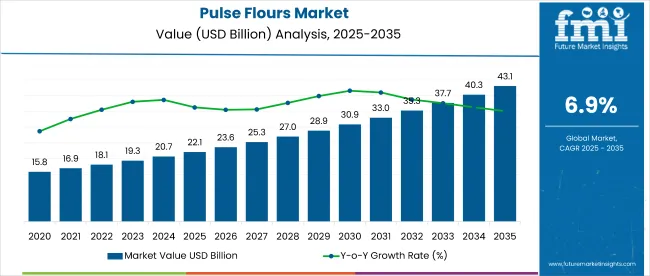
| Attributes | Description |
|---|---|
| Estimated Size (2025E) | USD 22.1 billion |
| Projected Value (2035F) | USD 43.6 billion |
| Value-based CAGR (2025 to 2035) | 6.9% |
Pulse flours including pea, chickpea, lentil, and bean flours are rich in protein, fiber, and essential nutrients, making them ideal for bakery, snack, and convenience food applications. Advances in agricultural processing, clean-label formulations, and new product development are accelerating the adoption of pulse flours across both retail and industrial food sectors.
The market holds an estimated 38% share in the global gluten-free flours market, reflecting its strong position in health-driven product innovation. Within the broader plant-based ingredients market, pulse flours account for 7.2%, underscoring their relevance in vegetarian and vegan product formulations.
They contribute around 5.1% to the global functional flours segment, driven by their nutrient density and role in improving texture, protein content, and shelf stability. In the global clean-label ingredients market, pulse flours command a 3.4% share, thanks to their natural, non-GMO, and minimally processed characteristics. However, in the expansive processed food ingredients market, their share remains below 0.5%, indicating significant headroom for growth through consumer education and food industry innovation.
Government initiatives and regulatory frameworks across major regions including the United States, European Union, and India are supporting the pulse flour market's expansion. In the USA, the USDA’s support for sustainable agriculture and plant-forward diets is driving commercial R&D in pulses. In the EU, environmental policies promoting crop rotation and soil health have led to greater incentives for pulse cultivation.
In India, where pulses are a dietary staple, national nutrition programs and support for pulse-based food innovation are fueling domestic and export demand. These policy frameworks are creating a robust foundation for resilient, health-centric, and environmentally sustainable food systems globally.
Japan is projected to be the fastest-growing market in the global pulse flours industry, expected to expand at a CAGR of 7.2% from 2025 to 2035. Food & beverage will lead the application segment with a 36% share, while pea will dominate the product type segment with a 34% share in 2025. The USA and UK markets are also expected to grow steadily, registering CAGRs of 6.8% and 6.5%, respectively.
The market is segmented by product type, application, distribution channel, and region. By product type, the market is divided into pea, chickpea, bean, and lentil. In terms of application, the market includes food & beverages (bakery products, snacks, meat products, beverages), feed, and others (Baby food, sauces & dressings, plant-based dairy alternatives, and nutritional supplements).
By distribution channel, the market is categorized into food chain services, modern trade, convenience stores, departmental stores, online stores, and other channels (health food stores, specialty ingredient retailers, direct-to-consumer (D2C) sales, and co-operative outlets). Regionally, the market is classified into North America, Latin America, Europe, East Asia, South Asia, Oceania, and the Middle East & Africa (MEA).
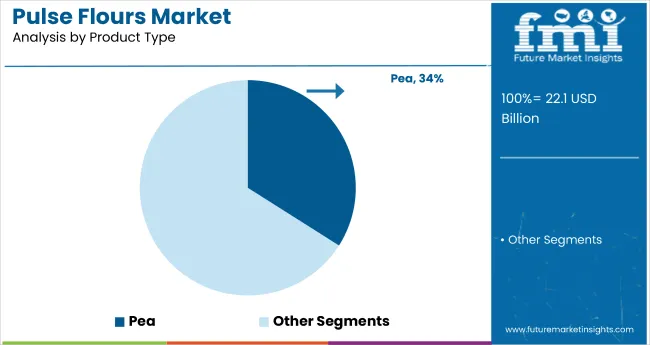
Pea is projected to lead the product type segment with a 34% market share by 2025, driven by its functional benefits in gluten-free applications, high protein content, and wide acceptance among consumers seeking plant-based alternatives.
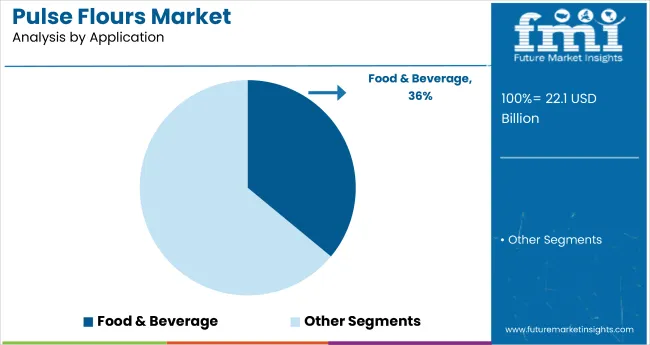
Food & Beverage is expected to dominate within the food & beverages segment, capturing 36% of the total market by 2025. Pulse flours are increasingly used in bread, muffins, and cookies due to their gluten-free and protein-rich properties.
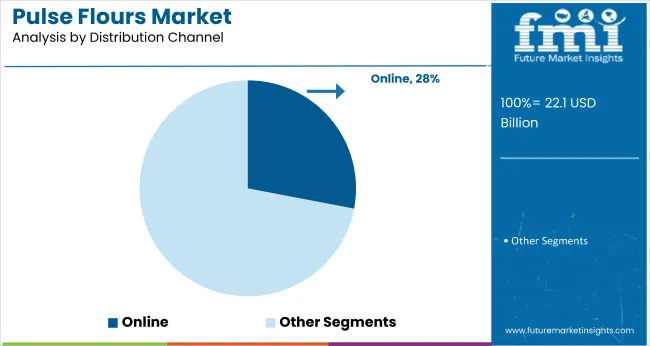
Online store is projected to capture 28% of the market share by 2025, becoming the most dynamic channel for pulse flour distribution. The digital retail platform supports the rise in D2C health food brands and consumer access to specialty ingredients.
The global pulse flours market is witnessing robust growth, fueled by rising health consciousness, demand for gluten-free alternatives, and the push toward plant-based nutrition. Pulse flours derived from peas, lentils, chickpeas, and beans are increasingly used across food, feed, and functional applications for their rich protein and fiber content, as well as their sustainable agricultural footprint.
Recent Trends in the Pulse Flours Market
Challenges in the Pulse Flours Market

The market growth rates vary across key countries from 2025 to 2035. Japan leads with a CAGR of 7.2%, driven by rising demand for gluten-free bakery and plant-based snacks. The USA follows with 6.8%, supported by plant-based diets and innovation in convenient foods.
France and Germany grow at 6.7% and 6.6%, respectively, fueled by EU nutrition guidelines and sustainability initiatives. The UK records the slowest growth at 6.5%, influenced by cautious post-Brexit investment. Despite differences, all markets show steady expansion, with Japan and the USA slightly outpacing European counterparts in Pulse Flours adoption.
The report covers in-depth analysis of 40+ countries; five top-performing OECD countries are highlighted below.
The Japan pulse flours revenue is growing at a CAGR of 7.2% from 2025 to 2035. Growth is driven by rising demand for gluten-free bakery products and plant-based protein snacks.
The sales of pulse flours in Germany are expected to expand at 6.6% CAGR during the forecast period, slightly below the global average but strongly regulation led. EU sustainability goals and health-focused food policies are pushing adoption of pulse-based ingredients.
The French pulse flours market is projected to grow at a 6.7% CAGR during the forecast period, closely mirroring Germany in its policy-backed adoption. Demand is driven by national dietary guidelines, clean-label food trends, and sustainable agriculture initiatives.
The USA pulse flours market is projected to grow at 6.8% CAGR from 2025 to 2035, translating to 0.98 times the global rate. USA demand is driven by the rise of plant-based diets, gluten-free trends, and innovation in food formulations.
The UK pulse flours revenue is projected to grow at a CAGR of 6.5% from 2025 to 2035, representing the slowest growth among the top OECD nations, at 0.94 times the global pace. Growth is supported by health-conscious consumer behaviour and increased use in fortified and convenience foods.
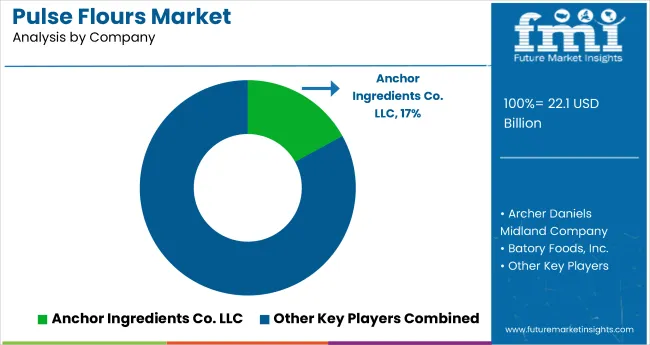
The market is moderately consolidated, with leading players like Anchor Ingredients Co. LLC, Archer Daniels Midland Company, Batory Foods, Inc., CanMar Grain Products, and SunOpta, Inc. dominating the industry. These companies cater to the food and beverage, bakery, and snack sectors with high-quality plant-based products.
Anchor Ingredients Co. LLC specializes in customized flours and protein concentrates, while Archer Daniels Midland Company offers a wide range of legume-based solutions. Batory Foods, Inc. focuses on sourcing and processing diverse legume varieties.
CanMar Grain Products delivers bulk commodities for industrial applications, and SunOpta, Inc. is known for organic and non-GMO offerings. Other key players like Best Cooking Pulses Inc., Blue Ribbon Grain & Pulses Pty Ltd, Diefenbaker Spice & Pulse, Ehl Ingredients Limited, Great Western Grain Company Ltd, Ingredion Incorporated, and Parakh Agro Industries Limited contribute by providing specialized legume-derived products for global markets.
| Report Attributes | Details |
|---|---|
| Market Size (2025) | USD 22.1 billion |
| Projected Market Size (2035) | USD 43.6 billion |
| CAGR (2025 to 2035) | 6.9% |
| Base Year for Estimation | 2024 |
| Historical Period | 2020 to 2024 |
| Projections Period | 2025 to 2035 |
| Report Parameter | USD million for value/volume in metric tons |
| Product Types Analyzed | Pea, Chickpea, Bean, and Lentil |
| Application Analyzed | Food & Beverages (Bakery Products, Snacks, Meat Products, Beverage), Feed, and Others (Baby Food, Sauces & Dressings, Plant-Based Dairy Alternatives, and Nutritional Supplements) |
| Distribution Channel Analyzed | Food Chain Services, Modern Trade, Convenience Store, Departmental Store, Online Store, and Other Channels (Health Food Stores, Specialty Ingredient Retailers, Direct-to-Consumer (D2C) Sales, And Co-Operative Outlets) |
| Regions Covered | North America, Latin America, Europe, East Asia, South Asia, Oceania, Middle East & Africa |
| Countries Covered | United States, United Kingdom, Germany, France, Japan, China, India, Brazil, South Korea, Australia |
| Key Players Influencing the Market | Anchor Ingredients Co. LLC, Archer Daniels Midland Company, Batory Foods, Inc., Bean Growers Australia Limited, Best Cooking Pulses Inc., Blue Ribbon Grain & Pulses Pty Ltd, CanMar Grain Products, Diefenbaker Spice & Pulse, Ehl Ingredients Limited, Great Western Grain Company Ltd, Ingredion Incorporated, Parakh Agro Industries Limited, SunOpta, Inc., The Scoular Company |
| Additional Attributes | Dollar sales by product type, share by application, regional demand growth, policy influence, sustainability trends, competitive benchmarking |
The global pulse flours market is estimated to be valued at USD 22.1 billion in 2025.
The market size for the pulse flours market is projected to reach USD 43.1 billion by 2035.
The pulse flours market is expected to grow at a 6.9% CAGR between 2025 and 2035.
The key product types in pulse flours market are chickpea, lentils, pea, beans and other product types.
In terms of application, bakery and confectionery segment to command 42.7% share in the pulse flours market in 2025.






Our Research Products

The "Full Research Suite" delivers actionable market intel, deep dives on markets or technologies, so clients act faster, cut risk, and unlock growth.

The Leaderboard benchmarks and ranks top vendors, classifying them as Established Leaders, Leading Challengers, or Disruptors & Challengers.

Locates where complements amplify value and substitutes erode it, forecasting net impact by horizon

We deliver granular, decision-grade intel: market sizing, 5-year forecasts, pricing, adoption, usage, revenue, and operational KPIs—plus competitor tracking, regulation, and value chains—across 60 countries broadly.

Spot the shifts before they hit your P&L. We track inflection points, adoption curves, pricing moves, and ecosystem plays to show where demand is heading, why it is changing, and what to do next across high-growth markets and disruptive tech

Real-time reads of user behavior. We track shifting priorities, perceptions of today’s and next-gen services, and provider experience, then pace how fast tech moves from trial to adoption, blending buyer, consumer, and channel inputs with social signals (#WhySwitch, #UX).

Partner with our analyst team to build a custom report designed around your business priorities. From analysing market trends to assessing competitors or crafting bespoke datasets, we tailor insights to your needs.
Supplier Intelligence
Discovery & Profiling
Capacity & Footprint
Performance & Risk
Compliance & Governance
Commercial Readiness
Who Supplies Whom
Scorecards & Shortlists
Playbooks & Docs
Category Intelligence
Definition & Scope
Demand & Use Cases
Cost Drivers
Market Structure
Supply Chain Map
Trade & Policy
Operating Norms
Deliverables
Buyer Intelligence
Account Basics
Spend & Scope
Procurement Model
Vendor Requirements
Terms & Policies
Entry Strategy
Pain Points & Triggers
Outputs
Pricing Analysis
Benchmarks
Trends
Should-Cost
Indexation
Landed Cost
Commercial Terms
Deliverables
Brand Analysis
Positioning & Value Prop
Share & Presence
Customer Evidence
Go-to-Market
Digital & Reputation
Compliance & Trust
KPIs & Gaps
Outputs
Full Research Suite comprises of:
Market outlook & trends analysis
Interviews & case studies
Strategic recommendations
Vendor profiles & capabilities analysis
5-year forecasts
8 regions and 60+ country-level data splits
Market segment data splits
12 months of continuous data updates
DELIVERED AS:
PDF EXCEL ONLINE
Pulse Ingredient Industry Analysis in Japan Size and Share Forecast Outlook 2025 to 2035
Pulse Ingredient Industry Analysis in Western Europe Size and Share Forecast Outlook 2025 to 2035
Pulse Ingredient Industry Analysis in Korea Size and Share Forecast Outlook 2025 to 2035
Pulse Safety Resistor Market Size and Share Forecast Outlook 2025 to 2035
Pulses Market Analysis - Size, Share, & Forecast Outlook 2025 to 2035
Pulse Lavage Market Size and Share Forecast Outlook 2025 to 2035
Pulse Electromagnetic Field Therapy Devices Market Size and Share Forecast Outlook 2025 to 2035
Pulse Ingredients Market Analysis – Size, Share, and Forecast 2025 to 2035
Pulse Oximeter Market Size and Share Forecast Outlook 2025 to 2035
Pulse Width Modulation Controllers Market Size and Share Forecast Outlook 2025 to 2035
Pulse Products Market Analysis - Size, Share, and Forecast Outlook 2025 to 2035
Analyzing Pulses Market Share & Industry Trends
Pulsed Field Ablation Market Analysis by Product, End User, and Region - Forecast for 2025 to 2035
Pulse Generator Market
UK Pulses Market Growth – Trends, Demand & Innovations 2025–2035
MRI Pulse Oximeters Market Size and Share Forecast Outlook 2025 to 2035
USA Pulses Market Insights – Demand, Size & Industry Trends 2025–2035
LiDAR Pulsed Fiber Laser Market Size and Share Forecast Outlook 2025 to 2035
Smart Pulse Oximeters Market Size and Share Forecast Outlook 2025 to 2035
ASEAN Pulses Market Analysis – Size, Share & Forecast 2025–2035

Thank you!
You will receive an email from our Business Development Manager. Please be sure to check your SPAM/JUNK folder too.
Chat With
MaRIA